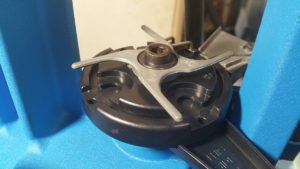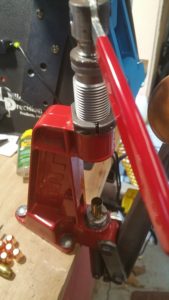I am pretty comfortable with my current 40S&W load 180 grain bullets on 4.35 grains Winchester 231. It’s a pretty solid 800 fps for 144 power factor and 256 ft/lbs muzzle energy. It runs the pistol well, too.
I set up the chronograph and got ready to play with the powder measure. I threw 10 loads of powder, weighed it and divided by 10. When I set the measure up, this method showed the charge to be 4.35 grains. It came out this time as 4.25 grains, so I ran it again and got 4.25 grains again. Now, the whole assembly had been moved to the loaner press and back, so a small change might not be surprising. Then again, I should have spot checked it at least after each move. Next time.
So, I reduced the charge, weighed it and failed do document the weight for it and the next three charges. At least I did document the average velocities for 5 shots.
773 fps = 139PF = 239 ft/lbs
762 fps = 137PF = 232 ft/lbs
750 fps = 135PF = 225 ft/lbs
735 fps = 132PF = 216 ft/lbs
I landed on 3.85 grains for 724 fps, 130PF & 209 ft/lbs. I ran about 20 rounds through the chrono to verify that it was stable at this velocity.
I like to experiment with loads and bullet weights, so I left the charge at 3.85 grains, but loaded ten 155 grain plated bullets. The average came out to 643 fps, 99PF & 142 ft/lbs. As it turns out, 142 ft/lbs is not enough to run the pistol. In fact, it exactly zero rounds ejected, though a couple did open the slide a bit. The brass showed soot smudging on the outside. I think the surprisingly large drop in velocity and the sooty cases indicates that the pressure dropped significantly, maybe because the 155 grain bullet is quite a bit shorter than the 180, but I have them seated to the same OAL, leaving a larger space in the cartridge.
The 165 grain poly-coated bullets did a little better, 748 fps, 123 PF & 205 ft/lbs. The pistol ran just fine, but that power factor is a little too low. I should be able to tweak the charge for all those 155 and 165 grain bullets I have left from when I started loading 180’s. 🙂








